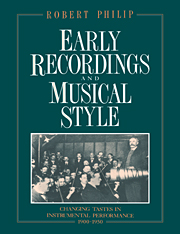7 - Orchestral portamento
Published online by Cambridge University Press: 22 September 2009
Summary
INTRODUCTION
In many ways orchestral string-players of the early twentieth century shared the style and technique of soloists and chamber musicians. In fact it is not really possible to separate string-players into these different categories. Then as now, most players led a varied professional life. All except the most renowned soloists spent much of their time playing in orchestras (including not only symphony orchestras but also theatres and hotels), and many orchestral players spent part of their time playing solo or chamber music. Again, then as now, students simply learned the violin or cello in the style of the day, whether they were in the end destined for a career as soloists or in orchestras.
Soloists and orchestral players therefore shared broad characteristics and trends. Presumably almost all orchestral players at the turn of the century played with gut strings, as recommended in the writings of the time, but by the 1930s most violinists would have adopted steel E strings. One would expect orchestral players at the turn of the century to play with frequent portamento and sparing vibrato, but by the 1930s with more vibrato and less portamento. That much is obvious. But orchestral playing is different from solo playing. Performing with a large number of string-players means, to some extent, sacrificing one's own tastes and characteristics to a corporate effect. How far this process goes will depend on the amount and quality of rehearsal, and on the general habits of the time.
- Type
- Chapter
- Information
- Early Recordings and Musical StyleChanging Tastes in Instrumental Performance, 1900–1950, pp. 179 - 204Publisher: Cambridge University PressPrint publication year: 1992



